Eco-Friendly Riding Vacations-Part I
Learn about “green” horseback riding holidays, where eco-tourism principles benefit the environment and local people.
by Jocelyn Pierce
As the environment becomes more exploited and vulnerable, ecotourism is a way for travelers to lessen their footprint while learning about sustainability and the importance of the preservation of the natural world. Ecotourism is one of the fastest growing sectors of the tourism industry. The International Ecotourism Society defines ecotourism as "responsible travel to natural areas that conserves the environment and improves the well-being of local people." Ecotourism minimizes impact, fosters environmental awareness, plays a role in conservation, and benefits local people.
By traveling on horseback, tourists can reach pristine areas they may not have been able to with other means of transportation while leaving little impact on the surrounding environment. Horses also help people to connect culturally, as a common denominator that enables travelers an authentic view into locals’ lives. While many vacations centered on horses and riding tours can be considered a form of ecotourism, here are a few that stand out.
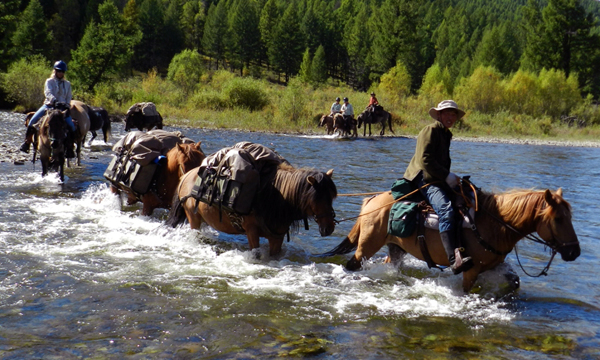
Crossing a river in Mongolia with Stone Horse Expeditions & Travel.
Stone Horse Expeditions & Travel
Keith Swenson, founder of Stone Horse Expeditions & Travel in Mongolia, has a life-long connection with wilderness experiences around the globe. With a background in park management and as a guide for various types of outfitters, Swenson has a deep understanding of the importance of wilderness and the associated tourism.
Swenson came to Mongolia in 1998 to work on Mongolia’s national park system. His recreational pastime of hopping on Mongolian horses to explore the surrounding wilderness soon morphed into a sound pack riding operation. As a member of the International Ecotourism Society, Stone Horse Expeditions & Travel adheres to their code of conduct and principles of ecotourism in addition to spreading wilderness knowledge to others.
Mongolian Horse Culture
Mongolia has a long history of horse culture traditions. Nomadic people have lived with and used horses to support their livelihoods for countless generations. The deep respect and reverence for the horse is highlighted with the Mongolian proverb, “a horse without a rider is still a horse, but a rider without a horse is just a man.”
Today about 170,000 Mongolian families still live a nomadic or semi nomadic lifestyle, moving seasonally with their livestock. The Mongolian horses are likened to the prehistoric Przewalski's horse, small and stocky, but rugged and easy going. Stone Horse Expeditions & Travel’s horses are accustomed to a “wild” lifestyle, living in a herd and roaming and grazing where they please.
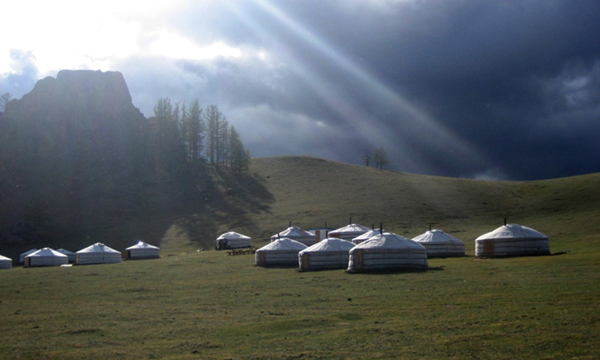
A ger camp in Mongolia in the afternoon sun.
Horseback Riding in Mongolia
Stone Horse Expeditions & Travel is extremely conscientious about having a minimal impact on the environment. Guests are picked up in the quickly modernizing capital city of Ulaanbaatar and are driven to the staging area for the expedition, about 45 kilometers away, ensuring the carbon footprint remains small by driving just a short distance. Once guests have arrived, no vehicles are used. Packhorses are used for all supplies and equipment on their tours.
Stone Horse Expeditions & Travel offers two packing trips. The journey to the Khentii Mountains, the largest roadless area in Mongolia, involves 12 days of horseback riding. Swenson and his team recognize the importance of this vast wilderness area, full of natural resources and wildlife. This ride is an experience of pure wilderness and solitude full of cultural and historical monuments.
It was in the Khentii Mountains that Genghis Khan was born and came to power, uniting the Mongol tribes and establishing the largest land empire in the world’s history. Riding through the backcountry is a true expedition, and one might imagine what it would have been like during the time of Genghis Khan.
The shorter horse pack trip meanders through the Gorkhi-Terelji National Park over 8 days of riding. The ride passes through landscapes of valleys, rivers, rolling fields, and farmland, while experiencing the local culture. No two trips are the same for Stone Horse Expeditions & Travel. They ride slightly different routes and camp in alternating areas to lessen their impact on the environment.
Working with the Community
Stone Horse Expeditions & Travel partners with the New Zealand Nature Institute and the Darkhid Valley Conservation Community and also works with the local community and government on ecological restoration, management, education and conservation. They are also big proponents of improving the livelihoods of local people. Guests of Stone Horse Expeditions & Travel can even participate in “Ger Stays,” where they stay with a local Mongolian herder family in their yurt and learn about their lifestyle.
Swenson feels a calling to show others the wilderness up close. By exposing tourists to some of Mongolia’s wildest areas, he hopes it will foster an understanding of its importance and the need to protect it. He believes all tourism should be ecotourism and encourages everyone to seek out operators who uphold responsible business ethics.
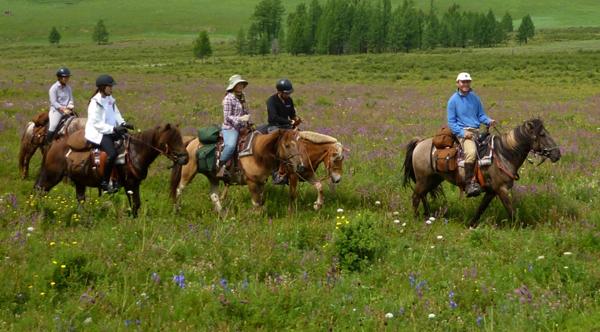
A small group rides through a field of wildflowers with Stone Horse Expeditions in Mongolia.
Zapata Ranch
Zapata Ranch is 103,000-acre working bison and guest ranch located east of the San Luis Valley in Southern Colorado, bordering Great Sand Dunes National Park and Preserve and surrounded by Colorado’s fourteeners, mountain peaks that exceed 14,000 feet elevation. The ranch has been owned by the Nature Conservancy Preserve since 1999 and is now managed by Ranchlands, an organization that aims to preserve the heritage of ranching. Duke Phillips, CEO of Ranchlands, calls Zapata the “Rocky Mountain Serengeti” because of its incredibly diverse landscape and wildlife.
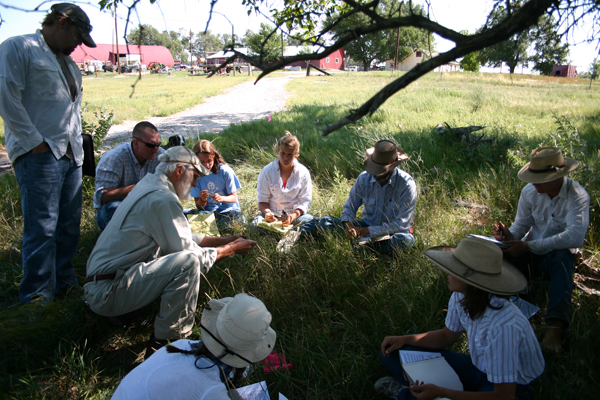
A group learns about grass management with Zapata Ranch.
Ranching and Conservation
As one of the United States’ oldest traditions, ranching is a way of life for many people who have a deep respect for the land and realize their responsibility to protect it. Zapata’s conservation bison herd is essentially treated as a wild herd. There is no branding, vaccinations, supplemental feeding, or weaning. The herd roams as it once did for thousands of years across the North American plains. Ranchlands implements programs aimed to benefit the whole ecosystem and consults with ecologists, botanists, and biologists.
Riding at Zapata
Guests of all experience levels are welcome at Zapata, and can even bring their own horse. There are opportunities to work and drive cattle, ride through the herd of bison, learn about their cattle grazing systems, and explore and learn about Sand Dunes National Park’s geology and sensitive ecosystem.
Zapata also offers overnight pack trips into the Sangre de Cristo Mountains during several weeks each summer where riders camp out in the wilderness. Phillips recognizes by participating in the day-to-day ranching activities, “it is an opportunity for people to be able to connect to the land in a world where the gulf between people and nature is getting wider every day.”
Educational Opportunities
Guests of Zapata are immersed in hands-on educational experiences. They can accompany naturalists to identify bird life and learn about their migratory patterns. They can ride out with cowboys to help with livestock management and learn about the bison herd, and can gain an understanding of Zapata’s basic practices and principles to protect the land.
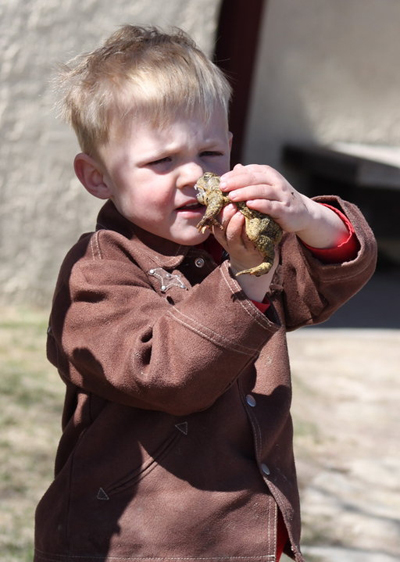
Even kids learn about wildlife and the importance of protecting the environment with Zapata Ranch.
Phillips believes that ecotourism “provides a window for the general public to learn about important methods that are being used to provide sound stewardship practices for the land.” When tourists come to Zapata and learn about their practices, they help support Ranchlands and their work in preserving this fragile landscape.
Although Stone Horse Expeditions & Travel and Zapata Ranch are two very different operations, their guiding principles of responsibility to the land and its inhabitants are paramount. They both work to minimize their impact while improving the surrounding environment. They seek to spread their knowledge of wilderness and conservation, hoping tourists will return home with responsible values and insight.
In part two of Eco-Friendly Riding Vacations, more ecotourism locales are highlighted.
About the Author: Jocelyn Pierce is an avid equestrian and lover of travel and photography. Her passion for adventure has led her on numerous excursions throughout North America and Europe. When she’s not riding and competing her homebred mare, she enjoys hiking, camping, and snapping photographs.




